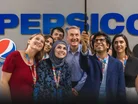Inside PepsiCo's Value Chain Sustainability Strategy

Each day, PepsiCo products such as Lay’s, Doritos, Gatorade and more than 500 other brands are consumed more than a billion times across more than 200 countries and territories.
With its roots dating back to 1898, PepsiCo has become one of the world’s most recognisable food and beverage brands.
The company, as we know it today, was born in 1965 from the merger of Pepsi-Cola and Frito-Lay Inc. and remains a global leader in its field.
Central to PepsiCo’s work is its sustainability strategy: pep+ (PepsiCo Positive). This approach, launched in 2021, drives the company’s vision of a more sustainable, people-focused future. It also addresses environmental and social challenges across its entire value chain, including Scope 3 emissions generated through upstream and downstream activities.
Pep+ focuses on three core pillars: Positive Agriculture, Positive Value Chain and Positive Choices.
Positive agriculture
Agriculture underpins everything PepsiCo does, from sourcing potatoes for Lay’s crisps to tomatoes for Alvalle Gazpacho.
However, with more than half of the world’s agricultural land degraded, global food security is at risk.
PepsiCo’s Positive Agriculture pillar aims to tackle this by supporting farmers and revitalising the land.
The company’s ambition is clear: “Thriving communities and ecosystems are essential to achieve a secure supply of crops on which our business relies, so we aspire to help farmers grow food in a way that revitalises the earth and supports their livelihoods.”
In 2023, PepsiCo doubled its regenerative farming footprint, to 1.8 million acres globally. This progress not only prevents land degradation but also promotes farmer well-being.
Since launching pep+, PepsiCo has reached more than 57,000 people in its agricultural supply chain through initiatives aimed at empowering women and fostering economic prosperity. Moreover, the company sustainably sourced 58% of its key ingredients last year.
Jim Andrew, PepsiCo’s Chief Sustainability Officer, emphasises the company’s gratitude towards farmers: “Without farmers, we wouldn’t have potatoes for Lay’s, corn for Doritos or oats for Quaker.
"Thank you for the dedication it takes to nurture high-quality crops while managing challenges like weather disruptions and regulations. We want to support a positive future for farmers.”
Positive value chain
PepsiCo’s value chain pillar addresses sustainability across climate, water, packaging and people. Each sub-pillar sets ambitious goals:
- Climate: PepsiCo is working towards net zero emissions by 2040. Initiatives include fleet decarbonisation with electric vehicles and renewable energy investments such as biogas, as well as strategies to address Scope 3 emissions, such as supplier engagement and sustainable sourcing practices.
- Water: The company achieved a 25% improvement in water-use efficiency two years ahead of its 2025 goal, a major step towards its aim of having a “net water positive impact.”
- Packaging: With a vision to eliminate packaging waste, the SodaStream platform has led the charge by helping consumers avoid more than 200 billion plastic bottles by 2030.
- People: PepsiCo is committed to diversity, equity and inclusion (DEI), with women holding 45% of managerial roles globally.
“Our sustainable packaging approach is grounded in a vision to create a world where packaging never becomes waste,” the company explains. This ambition ties into its broader commitment to sustainability, including addressing Scope 3 emissions tied to the lifecycle of its products, reflecting its determination to innovate at every level of its operations.
It's not just a business strategy — it's a transformative journey across our operations, from production to marketing to distribution.
It's our vision to deliver a more sustainable, people-centric future, driving growth and value, for everyone.
Positive choices
The final pillar, Positive Choices, focuses on giving consumers healthier, more sustainable options as PepsiCo aims to inspire choices that benefit both people and the planet.
In 2023, the company introduced two new nutrition goals to be achieved by 2030. These include reducing sodium in products and incorporating more diverse ingredients, tying into its Positive Agriculture efforts.
By combining convenience with nutrition, PepsiCo ensures its customers can choose what works best for them without compromising their health or the environment.
The future of pep+
PepsiCo has already achieved several of its 2025 goals, such as improving water-use efficiency and expanding regenerative farming.
However, the company acknowledges the challenges ahead, as sustainability goals require ongoing investment, partnerships and innovation.
“Since launching pep+, we’ve been transforming the way we do business to make us more resilient for the future,” explains Jim.
“Through investment, innovative thinking, partnership and the impactful actions of our global associates, we’ve already reached some of our goals and made excellent progress on others.”
As PepsiCo moves forward, it stays rooted in its mission to create a better future for people, farmers and the planet.
Make sure you check out the latest industry news and insights at Scope 3 Magazine and be part of the conversation at our global conference series, Sustainability LIVE and Procurement & Supply Chain LIVE.
Discover all our upcoming events and secure your tickets today. Subscribe to the Scope 3 Magazine newsletter.
Scope 3 Magazine is a BizClik brand.
Featured Articles
Estonia, Latvia and Lithuania join the European grid, cutting ties with Russian energy, a move that boosts regional security and sustainability
TÜV SÜD: New battery regulations bring Scope 3 hurdles, requiring sustainable sourcing, digital traceability and design changes increasing compliance
Nissan is scaling up its use of green steel, reducing CO2 emissions in its supply chain as part of its goal to achieve carbon neutrality by 2050

